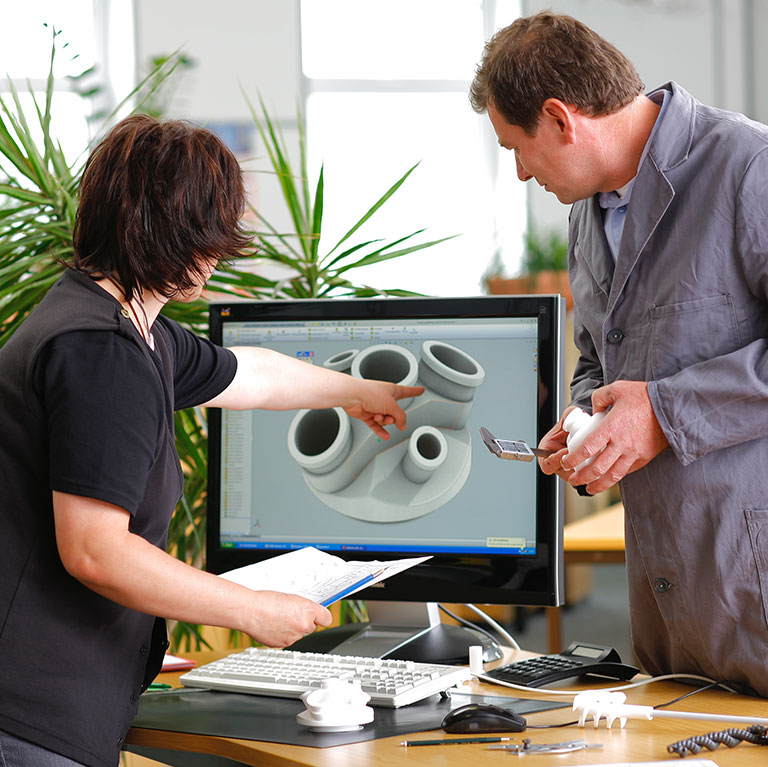Choice of stirring elements
With the following we would like to assist you in the choice of stirrer shafts. All stated values are experienced data established by experimentation and practical testing. All stirring elements are made for clockwise rotation (view from the top of the stirring agitator).
The diameter of the stirring shaft depends on the products used as well as on their viscosity. The higher the viscosity, the larger the shaft diameter. If you are in doubt, you should choose always the larger shaft diameter, in most cases it is possible to reduce the chucking diameter.
Stirrer shafts with a diameter of 8, 10 and 16 mm are most commonly used. For standard applications up to a rotation speed of 350 rpm and a max. length of 600 mm, a shaft diameter of 10 mm will be sufficient. For stirring of high viscous products or shaft lengths over 600 mm, it should be checked whether the use of a stirrer shaft with 16 mm will make sense. Furthermore, adequate stirrer bearings and chucks at the agitor should be available.
Do not forget that the ideal diameter of the stirring element also will go through the “bottleneck” of your vessel, e. g. a ground joint or a flange. A tiltable stirrer blade might be helpful.
Example Propeller Stirrer Shaft:
Assumption: Inner diameter of the vessel (D) = 300 mm
1. Determination of the outer diameter of the stirring element R = (0.2 to 0.4) x D, thereafter follows 90 mm = 0.3 x 300 mm. Recommended outer diameter of the stirrer element is 90 mm.
2. Determination of the distance of the stirrer to the bottom B = (1 to 1,5) x R, thereafter follows 120 mm = 1,2 x 100 mm. The recommended distance of the stirrer to the bottom is 120 mm.
Signs and symbols:
- D Inner diameter of the vessel
- R Outer diameter of the stirring element (stirring diameter)
- B Distance of the stirrer to the bottom
- H Height of the stirring element
Propeller stirrer shafts
Stirrer shaft with several, inclined, arched and partly twisted blades. Also with draught tube. Stirring effect is based on a mainly axial flow which moves away from the agitator; changes in the blade inclination or rotating direction result in a change of the flow direction.
R = (0.2 to 0.4) x D
B = (1.0 to 1.5) x R

Discoidal stirrer shafts
Stirrer shaft with a blade with several, plane or curved paddles. Stirring effect is based on a radial, outwards directed flow with axial suction from the bottom and the top. The dispersing liquid is exposed to a high shearing.
R = (0.3 to 0.4) x D
H = 0.2 x R
B = R

Impeller stirrer shafts
Stirrer shaft with three angular, arched paddles. The stirring effect is based on a radial flow which is diverted axially due to the ground level position of the stirrer.
R = (0.50 to 0.70) x D
H = (0.12 to 0.17) x R
B = (0.08 to 0.18) x R

Stirrer Shafts with rigid paddle
Stirrer with a narrow blade. The stirring effect is based on a radial and axial flow. The product is opposed to shear forces ranging from moderate to strong.
R = (0.70 to 0.9) x D
H = (0.05 to 0.1) x R
B = (0.10 to 0.2) x R

Stirrer Shafts with rigid blade
Solid, plane blade in user-defined form. Stirring effect due to different rotation speeds of the product displaced by stirring and the residual vessel content.
R = (0.4 to 0.5) x D
H = (0.9 to 1) x R
B = 0.3 x R

Stirrer Shafts with angular blades
Stirrer shaft with several inclined, rectangular, straight blades (special form a2 = 90 degrees, also curved blades). The stirring effect is based on an axially directed flow combined with an increased shear rate. Reversion of the flow can be obtained by changing the inclination of the blades or the rotation direction.
R = (0.30 to 0.40) x D
H = (0.15 to 0.25) x R
B = (0.50 to 1.00) x R

U-shaped stirrer shafts
Anchor stirrer blade adapted to the vessel’s wall, reaches from edge to edge. The stirring effect is based on a mainly tangential flow with poor axial forces.
R = (0.90 to 0.95) x D
H = (0.50 to 1.00) x R
B = (0.003 to 0.005) x R

Double impulse stirrer shafts
Stirrer shaft with two contrarily aligned blades on a radial arm. The stirring effect is based on an axial flow with poor radial forces. Analogue to the conveying direction of the blades an axial flow arises near to the shaft. The conveying direction of the outer paddles is adapted to the mixing demands.
R = 0.70 x D
H = 0.20 x R
B = 0.28 x R

















